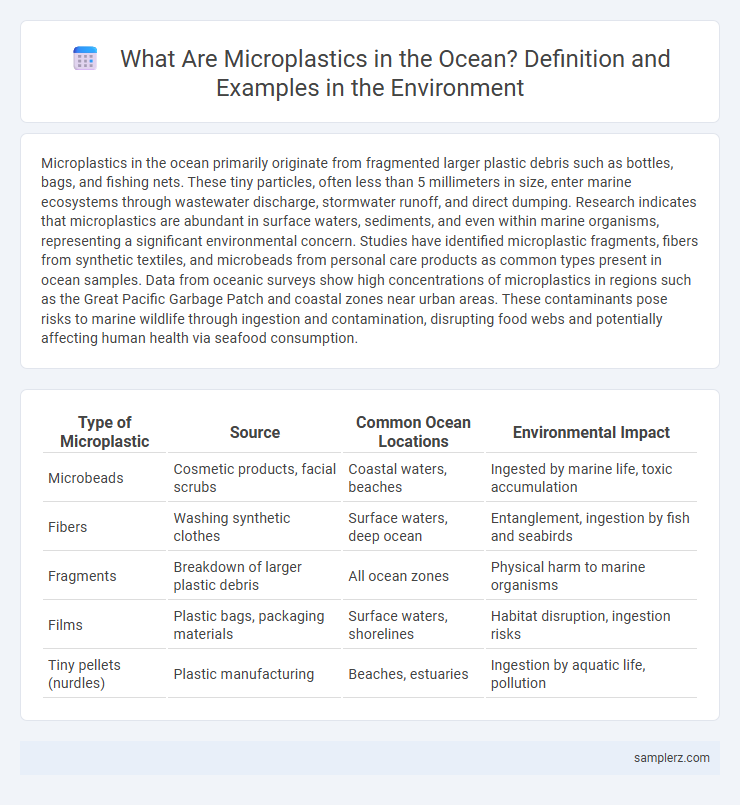Microplastics in the ocean primarily originate from fragmented larger plastic debris such as bottles, bags, and fishing nets. These tiny particles, often less than 5 millimeters in size, enter marine ecosystems through wastewater discharge, stormwater runoff, and direct dumping. Research indicates that microplastics are abundant in surface waters, sediments, and even within marine organisms, representing a significant environmental concern. Studies have identified microplastic fragments, fibers from synthetic textiles, and microbeads from personal care products as common types present in ocean samples. Data from oceanic surveys show high concentrations of microplastics in regions such as the Great Pacific Garbage Patch and coastal zones near urban areas. These contaminants pose risks to marine wildlife through ingestion and contamination, disrupting food webs and potentially affecting human health via seafood consumption.
Table of Comparison
| Type of Microplastic | Source | Common Ocean Locations | Environmental Impact |
|---|---|---|---|
| Microbeads | Cosmetic products, facial scrubs | Coastal waters, beaches | Ingested by marine life, toxic accumulation |
| Fibers | Washing synthetic clothes | Surface waters, deep ocean | Entanglement, ingestion by fish and seabirds |
| Fragments | Breakdown of larger plastic debris | All ocean zones | Physical harm to marine organisms |
| Films | Plastic bags, packaging materials | Surface waters, shorelines | Habitat disruption, ingestion risks |
| Tiny pellets (nurdles) | Plastic manufacturing | Beaches, estuaries | Ingestion by aquatic life, pollution |
Common Sources of Microplastics Found in Oceans
Microplastics in oceans primarily originate from the breakdown of larger plastic debris such as bottles, bags, and fishing nets that enter marine environments through river runoff and coastal littering. Synthetic fibers from laundering clothes and microbeads in personal care products also contribute significantly to microplastic pollution. These tiny plastic particles pose serious threats to marine life and ecosystems by contaminating the food chain and habitats.
Types of Microplastics Detected in Marine Environments
Microplastics in marine environments primarily consist of polyethylene (PE), polypropylene (PP), and polystyrene (PS), which are prevalent due to their widespread use in consumer products. Fibers from synthetic textiles like polyester and nylon represent a significant portion of microplastic pollution, often released during washing cycles. Fragmented particles from larger plastic debris, such as microbeads from personal care products, contribute to the diversity and persistence of microplastics throughout ocean ecosystems.
Microplastic Fragments from Consumer Products
Microplastic fragments from consumer products such as exfoliating scrubs, synthetic clothing fibers, and degraded plastic packaging significantly contribute to ocean pollution. These tiny particles, often less than 5 millimeters in size, accumulate in marine ecosystems, threatening biodiversity and entering the food chain through ingestion by fish and other aquatic organisms. Studies indicate that microplastic contamination affects over 90% of global ocean surfaces, highlighting the urgent need for improved waste management and product design.
Microbeads in Personal Care Items Polluting the Ocean
Microbeads, tiny plastic particles found in personal care products like exfoliating scrubs and toothpaste, contribute significantly to ocean microplastic pollution. These microbeads are non-biodegradable and enter marine ecosystems through wastewater treatment plants, accumulating in water bodies and harming aquatic life. Studies show that millions of microbeads are released into oceans daily, contaminating food chains and posing long-term environmental risks.
Synthetic Fibers from Laundry in Marine Ecosystems
Synthetic fibers from laundry, primarily polyester, nylon, and acrylic, constitute a significant portion of microplastic pollution in marine ecosystems. These microfibers are shed during washing and enter waterways through wastewater discharge, accumulating in oceans and adversely affecting marine life such as fish, plankton, and seabirds. Research indicates that synthetic microfibers contribute up to 85% of microplastic pollution in some coastal regions, highlighting the urgent need for improved filtration technologies and sustainable textile alternatives.
Microplastics from Fishing Gear and Nets
Microplastics from fishing gear and nets are significant contributors to ocean pollution, as these synthetic materials slowly degrade into tiny plastic particles harmful to marine ecosystems. Lost or discarded fishing nets, often called "ghost nets," release microplastics that entangle marine life and disrupt habitats. Studies show that fishing-related microplastics account for approximately 10% of the total microplastic debris found in the world's oceans, posing lasting environmental threats.
Breakdown of Larger Plastic Debris in Ocean Waters
Microplastics in ocean waters primarily result from the breakdown of larger plastic debris such as discarded bottles, fishing nets, and packaging materials, which fragment into tiny particles due to UV radiation and wave action. Studies estimate that over 90% of microplastics originate from the fragmentation of macroplastic waste found across marine environments. These microplastics pose significant threats to marine ecosystems by entering food chains and causing physical and chemical harm to aquatic organisms.
Microplastics in Marine Food Chains and Wildlife
Microplastics, including fragments from synthetic fibers and microbeads from personal care products, infiltrate marine food chains by being ingested by plankton and small fish. These contaminants accumulate as predators consume smaller prey, leading to bioaccumulation of toxic substances in larger marine animals like seabirds, turtles, and whales. The pervasive presence of microplastics disrupts marine ecosystems, threatening biodiversity and the health of wildlife populations.
Atmospheric Deposition of Microplastics into Seas
Atmospheric deposition of microplastics significantly contributes to ocean pollution as airborne particles from urban areas, industrial emissions, and synthetic textiles are transported by wind and settle on sea surfaces. Studies reveal that microplastics ranging from 1 to 100 micrometers are deposited in remote marine environments, impacting water quality and marine life. This pathway introduces contaminants beyond direct plastic waste, highlighting the pervasive nature of microplastic pollution in the oceanic ecosystem.
Microplastics from Industrial Waste and Runoff
Microplastics originating from industrial waste and runoff significantly contribute to ocean pollution, as factories release synthetic fibers, plastic pellets, and chemical residues into waterways. These microplastic particles accumulate in marine ecosystems, affecting aquatic life and entering the food chain with toxic consequences. Monitoring industrial discharge and enhancing wastewater treatment are crucial steps to reduce microplastic contamination in oceans.

example of microplastic in ocean Infographic
 samplerz.com
samplerz.com